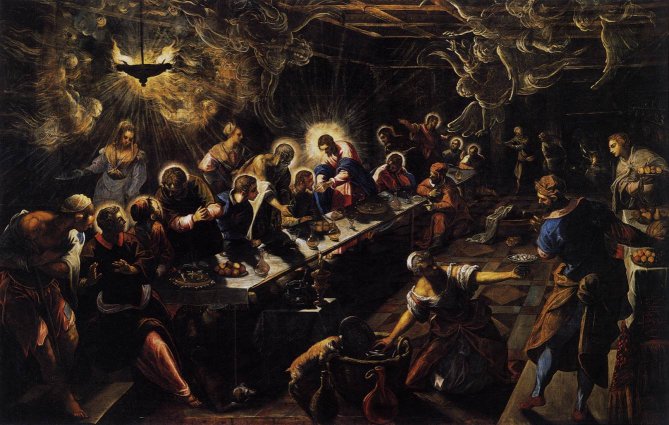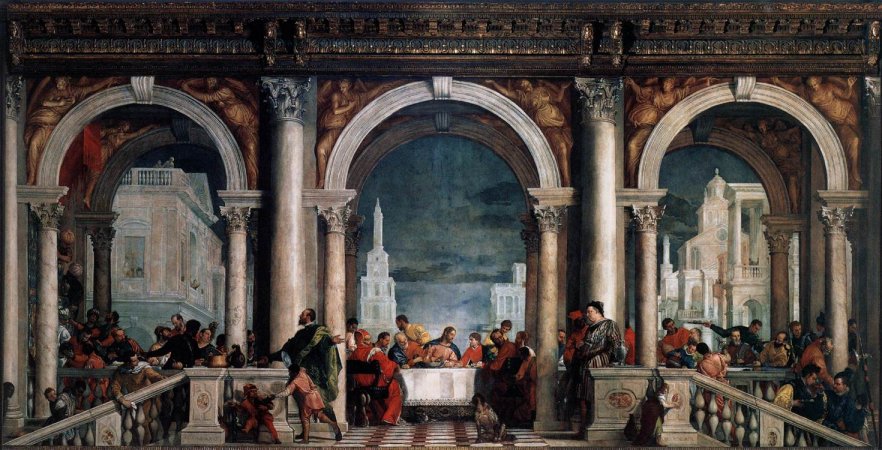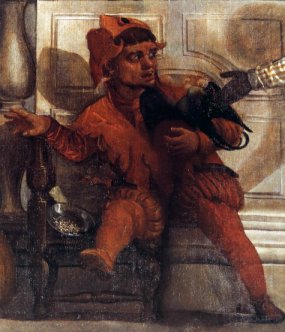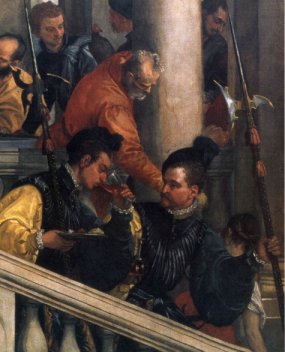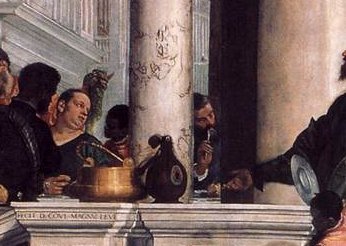|
The Passion of Christ |
|
|
The Last Supper - 6: after Leonardo |
|
|
For a final look at this topic, I'm going to look at two Venetian paintings, created within twenty years of each other. First, here's Tintoretto. |
|
|
|
|
| Tintoretto painted at least eight versions of the Last supper, and this one, from 1592-4, was his last. It is still in the location for which it was painted, the presbytery of San Giorgio Maggiore. | |
|
|
|
| No, this ISN'T a Last Supper, and it's very important to stress this. Any suggestion that it is could put the immortal soul of Veronese, who painted it in 1573, at some risk. Well, possibly. | |
|
Let's look at the Tintoretto first. It was painted for the church rather than the convent refectory. The refectory already had a painting, a huge Veronese. This was also not the Last Supper but a Wedding at Cana, eventually pinched by Napoleon and now in the Louvre. (A few years ago a full size photographic reproduction on canvas was placed in the original position, and very impressive it was too.) The painting has one of those unusual viewpoints that Tintoretto was so fond of - if he lived today he would be in great demand as an illustrator for graphic novels. It wasn't just whimsy though; its position in the presbytery is on the wall to the right of the altar, thus seeming to continue the altar on into space. For me this painting hits the spot in so many ways. Yes, the stillness of earlier versions of the Last Supper have given way to frenetic mannerist twisting and turning, and yet the lighting, and the swirling angels, give the painting a visionary, sacramental quality. Its position next to the altar in the church (rather than in a busy dining room) allowed Tintoretto to emphasise the Eucharistic elements of the scene. In the centre, a standing Christ places bread into the mouth of an disciple. That burst of light around Christ, echoed by the flaming lantern, focuses our attention on that sacred moment. |
|
|
So, on to Veronese. In 1572 he was commissioned to paint a Last Supper for the refectory of the Convent of San Giovanni e Paolo (San Zanipolo in Venetian.) His clients were very pleased with it - the Inquisition was not. He was accused of including elements entirely unsuitable for a Last Supper: 'drunken buffoons, armed Germans, dwarfs and similar absurdities' |
|
|
|
|
|
Some of Veronese's absurdities. The German soldiers, a from country over-run with heretical Protestants, particularly annoyed the Inquisition. |
|
|
In A History of Painting (1911) Haldane MacFall describes Veronese as in 'a state of dread' before his appearance before the Inquisition on July 8th 1573, but I wonder. The transcript is readily available on the internet, here amongst other places, and to my mind there is more than a touch of arrogance in Veronese's responses. Here is an example: Q. Who are the persons at the table of Our Lord? A. The twelve apostles. Q. What is Saint Peter doing, who is the first? A. He is carving the lamb in order to pass it to the other part of the table. Q. What is he doing who comes next? A. He holds a plate to see what Saint Peter will give him. Q. Tell us what the third is doing. A. He is picking his teeth with a fork. |
|
|
|
|
|
Veronese offered two defences of his picture, one unconvincing and the other very arrogant indeed. His unconvincing excuse was that the incidental 'absurdities' were actually outside the room in which the Last Supper took place. His second defence has been seen, ever since, as a declaration of the rights of the creative artist to exercise his or her imagination in any way they see appropriate: 'We painters use the same license as poets and madmen . . . .. I paint my pictures with all the considerations which are natural to my intelligence, and according as my intelligence understands them.' The Inquisition were not convinced. they insisted that Veronese changed the picture. He did no such thing; he changed the title instead, to 'Feast in the House of Levi', thus cocking a final snook at the Inquisition. There are some interesting aspects to this story. As far as the Catholic church was concerned, Venice went its own way. The Inquisition was a feared organisation, but its writ did not run there to the same extent as elsewhere. To me, though, there is an even more curious aspect to the affair. In my discussion of Leonardo's Last Supper, I stressed the importance of the Eucharist to the Dominicans who were, incidentally, important enforcers of the Inquisition throughout Europe. San Zanipolo, where the monks were perfectly happy with the Veronese, was a Dominican Convent. And finally my view, for what it's worth. Well, perhaps surprisingly for an agnostic who creates things, I rather lean towards the Inquisition's point of view. The Last Supper is a sacred subject; Tintoretto builds on this to make a moving, visionary painting. I've no idea whether Tintoretto was a fan of St Gregory the Great, but this quotation describes the picture perfectly: 'Who among the faithful would doubt that at the exact moment of immolation heaven is opened to the voice of the priest; that the choirs of angels are present at the mystery of Jesus Christ; that the highest is united to the lowest, that Heaven and Earth are joined; that the visible and invisible become one?' (Dialogue IV) The Veronese, on the other hand, is magnificently impressive, but spiritually empty. |
|
